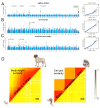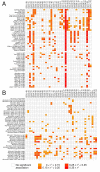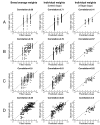A simple genetic architecture underlies morphological variation in dogs
- PMID: 20711490
- PMCID: PMC2919785
- DOI: 10.1371/journal.pbio.1000451
A simple genetic architecture underlies morphological variation in dogs
Abstract
Domestic dogs exhibit tremendous phenotypic diversity, including a greater variation in body size than any other terrestrial mammal. Here, we generate a high density map of canine genetic variation by genotyping 915 dogs from 80 domestic dog breeds, 83 wild canids, and 10 outbred African shelter dogs across 60,968 single-nucleotide polymorphisms (SNPs). Coupling this genomic resource with external measurements from breed standards and individuals as well as skeletal measurements from museum specimens, we identify 51 regions of the dog genome associated with phenotypic variation among breeds in 57 traits. The complex traits include average breed body size and external body dimensions and cranial, dental, and long bone shape and size with and without allometric scaling. In contrast to the results from association mapping of quantitative traits in humans and domesticated plants, we find that across dog breeds, a small number of quantitative trait loci (< or = 3) explain the majority of phenotypic variation for most of the traits we studied. In addition, many genomic regions show signatures of recent selection, with most of the highly differentiated regions being associated with breed-defining traits such as body size, coat characteristics, and ear floppiness. Our results demonstrate the efficacy of mapping multiple traits in the domestic dog using a database of genotyped individuals and highlight the important role human-directed selection has played in altering the genetic architecture of key traits in this important species.
Conflict of interest statement
The authors have declared that no competing interests exist.
Figures





Comment in
-
A dog's eye view of morphological diversity.PLoS Biol. 2010 Aug 10;8(8):e1000452. doi: 10.1371/journal.pbio.1000452. PLoS Biol. 2010. PMID: 20711480 Free PMC article. No abstract available.
References
-
- Wayne R. K, Ostrander E. A. Lessons learned from the dog genome. Trends in Genet. 2007;23:557–567. - PubMed
-
- Karlsson E. K, Baranowska I, Wade C. M, Salmon Hillbertz N. H. C, Zody M. C, et al. Efficient mapping of mendelian traits in dogs through genome-wide association. Nature Genetics. 2007;39:1321–1328. - PubMed
Publication types
MeSH terms
Grants and funding
LinkOut - more resources
Full Text Sources
Other Literature Sources
Medical

